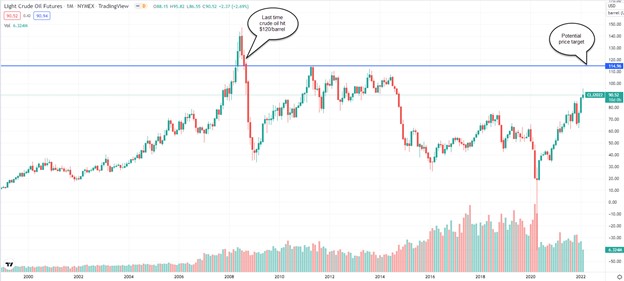The word on the “street” is that Russia’s potential invasion of Ukraine is “imminent”; that it can be a matter of days, hours, or even minutes. On the Eastern European side, the shadow of diplomacy still casts a figure on the negotiating table, but it’s fading fast.
Which way it goes is anyone’s guess. The Russia and Belarus joint military drills were scheduled to end last Sunday, February 20. However, that deadline had been extended, which is a concerning development as it opens the door equally to diplomacy as it does to more thorough military preparation. If most of the troops remain concentrated or begin maneuvering on the Ukraine border it could be an indicator of a possible invasion.
The markets are attempting to “price-in” the consequences of a worst-case scenario. And perhaps the commodity segment slated for the biggest volatility hit would be in the energy space, that is, Brent and WTI crude oil as well as natural gas.
Oil’s Wild Ride
Crude oil futures have been rising since December 2021, reaching a seven-year high of $95.82 per barrel on February 14, 2022. The main reason for the price rise—Russia’s threat against Ukraine. According to CEIC data, Russia exports approximately 4.7 million barrels of oil per day, making it one of the world’s largest oil producers. Russia is also Europe’s largest provider of oil. Since Russia is a big global supplier of oil, if there were an invasion, Russian crude exports would likely be cut. And that could mean a spike in oil prices, at least for the short term.
Don’t rule out the possibility of an uptick in US oil production. This might help make up for some of the supply shortfall. But will it be enough? Several energy experts expect crude oil prices to rise higher than $100 per barrel if tensions between the two countries continue. Analyst David Roche said that he believes oil will hit $120 a barrel. The last time crude was at that price was back in 2008 (see chart of light crude oil futures below). A more realistic price target would be at around the $110-115/barrel level, the high from 2011–2013.
Light Crude Oil Continuous Contract (CL) – Monthly Chart (source: Tradingview)

Natural Gas Could Follow Similar Path
When tensions escalated between Russia and Ukraine, natural gas futures prices also rose. Although prices have pulled back slightly in the last few trading days, there could be a price spike if an invasion were to take place. Natural gas plays an important role in European and Russian relations. Europe receives most of its natural gas from Russia via the Nord Stream 1 (NS1) pipeline which goes through Ukraine. The Nord Stream 2 (NS2) pipeline, which is completed but still awaiting approval for use, runs between Russia and Germany. This means Germany and other Western European countries will receive their natural gas directly from Russia without going through Ukraine.
If Russia invades, NS2 is likely to be a subject of political discourse. President Biden has made it clear that he wants to block NS2 and it seems like Germany is moving the needle in that direction. Russia could cut off all natural gas supplies via NS1 which would mean Europe would have to rely on countries such as the US and Qatar for its natural gas supply.
The Takeaway
It goes without saying that an invasion would impact the world economically and politically. Traders should keep a close eye on any developments in the political front as we head into the long weekend. Any geopolitical tension could send crude and natural gas futures prices higher even if the risk premium has already been priced in. Remember, futures contract prices are also impacted by supply and demand.
Please be aware that the content of this blog is based upon the opinions and research of GFF Brokers and its staff and should not be treated as trade recommendations. There is a substantial risk of loss in trading futures, options and forex. Past performance is not necessarily indicative of future results.
Disclaimer Regarding Hypothetical Performance Results: HYPOTHETICAL PERFORMANCE RESULTS HAVE MANY INHERENT LIMITATIONS, SOME OF WHICH ARE DESCRIBED BELOW. NO REPRESENTATION IS BEING MADE THAT ANY ACCOUNT WILL OR IS LIKELY TO ACHIEVE PROFITS OR LOSSES SIMILAR TO THOSE SHOWN. IN FACT, THERE ARE FREQUENTLY SHARP DIFFERENCES BETWEEN HYPOTHETICAL PERFORMANCE RESULTS AND THE ACTUAL RESULTS SUBSEQUENTLY ACHIEVED BY ANY PARTICULAR TRADING PROGRAM.
ONE OF THE LIMITATIONS OF HYPOTHETICAL PERFORMANCE RESULTS IS THAT THEY ARE GENERALLY PREPARED WITH THE BENEFIT OF HINDSIGHT. IN ADDITION, HYPOTHETICAL TRADING DOES NOT INVOLVE FINANCIAL RISK, AND NO HYPOTHETICAL TRADING RECORD CAN COMPLETELY ACCOUNT FOR THE IMPACT OF FINANCIAL RISK IN ACTUAL TRADING. FOR EXAMPLE, THE ABILITY TO WITHSTAND LOSSES OR TO ADHERE TO A PARTICULAR TRADING PROGRAM IN SPITE OF TRADING LOSSES ARE MATERIAL POINTS WHICH CAN ALSO ADVERSELY AFFECT ACTUAL TRADING RESULTS. THERE ARE NUMEROUS OTHER FACTORS RELATED TO THE MARKETS IN GENERAL OR TO THE IMPLEMENTATION OF ANY SPECIFIC TRADING PROGRAM WHICH CANNOT BE FULLY ACCOUNTED FOR IN THE PREPARATION OF HYPOTHETICAL PERFORMANCE RESULTS AND ALL OF WHICH CAN ADVERSELY AFFECT ACTUAL TRADING RESULTS.